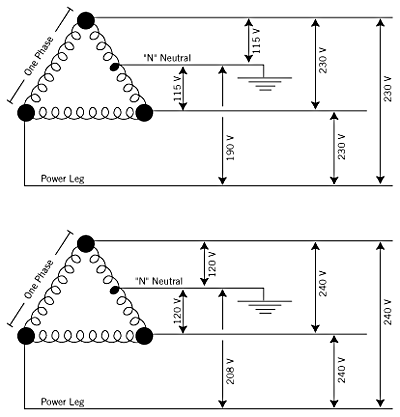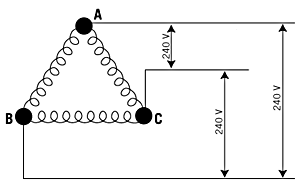Figure 1 shows a center-tapped Delta transformer. It also shows the power leg to neutral as being 208 V for a 240-V system and 190 V for a 230-V system. The different voltage magnitudes depend on the turn ratios of the primary to the secondary windings of the transformers.

The article in the April 7 issue ofThe Newsdealt with the Wye service transformer. Wye or “star” service transformers are one and the same. The names come from the secondary winding configuration looking like a Y or a three-sided star.
The Wye service is probably one of the most popular service drops in medium-size commercial buildings. It is a dual-voltage, three-phase service that delivers four wires to the building. There are actually three 120-V windings that are 120 degrees apart. (See Figure 2.) They consist of three hot wires and a neutral or ground.

The secondary winding of the Wye is center tapped and grounded. This makes the center tap or ground perfectly symmetrical to all three phases of its power. There is no wild or power leg in the Wye configuration, as there was in the Delta transformer’s center-tapped secondary.

Delta Advantages And Disadvantages
Delta service transformers’ secondary windings may only have three wires for service. (See Figure 3.) This type of service is usually for three-phase loads because it is electrically ungrounded.The use of this service for three-phase only makes it an easy system to keep balanced electrical loads. None of the three windings are center-tapped. There is no neutral conductor or wire, and all three wires are hot. This prevents the use of any low-voltage, single-phase loads off of this type of service transformer.
This type of service may be used along with a single-phase system. However, it is usually dedicated to three-phase power only. This type of arrangement is very easy to apply to balanced loads; at the same time, one does not have to worry about the wild leg. Depending on the turns ratio of the winding from primary to secondary, the voltage may be any popular voltage. This ability of the Delta service transformer to be electrically grounded or ungrounded adds to its versatility and is a definite advantage.
An advantage of the center-tapped Delta is its ability to meet a building’s need for 120-V single-phase power, 240-V single-phase power, and 240-V three-phase power in one transformer. Other popular voltages can be obtained with different turns ratios.
A Delta secondary is better for stepping down voltages than a Wye. You would have a higher step-down voltage with a Wye secondary because its line-to-line voltage encompasses two phases with a 120-degree angle between them.
A disadvantage of the Delta center-tapped service transformer is the fact that it has a wild leg. You had better know what you are doing, or else low-voltage, single-phase loads can be burned out due to high-voltage situations. (See the March 3 article.)
Another disadvantage of the Delta center-tapped service transformer is that most modern buildings have many needs for 120-V loads, and they can only be connected to two phases of the secondary. This creates a problem when it comes to load balancing. Often the building’s power load cannot be balanced properly on all three of the phase wires.
The Wye Advantage
An advantage of Wye service secondary it that it meets the needs for 120-V single-phase, 208-V single-phase, and 208-V three-phase power in a building. Some other popular voltages are 480 V single-phase, 480 V three-phase, and 277 V single-phase.Another advantage of the Wye is that there is no wild leg to burn out low-voltage, single-phase equipment. All single-phase loads may be connected to any winding of the Wye. Maximum and efficient use of all three conductors of the Wye can be utilized. The neutral or ground is brought out from the middle point of the Wye connection to be distributed evenly across the three phases.
Since the neutral wire is connected to the center of the secondary, which is common to each winding, the Wye is perfectly symmetrical. The power loads of the building can be balanced very easily.
Secondaries of transformers are often connected in Wye configuration to increase output voltage. Again, a line-to-line voltage encompasses two phases with a 120-degree angle between them. Line losses are reduced because the higher voltage allows for lower amperage; thus, the efficiency of the transformer is improved.
Tomczyk is a professor of HVAC at Ferris State University, Big Rapids, Mich., and the author of Troubleshooting and Servicing Modern Air Conditioning & Refrigeration Systems, published by ESCO Press. To order, call 800-726-9696. Tomczyk can be reached at tomczykj@tucker-usa.com.
Publication date: 06/02/2003

Report Abusive Comment